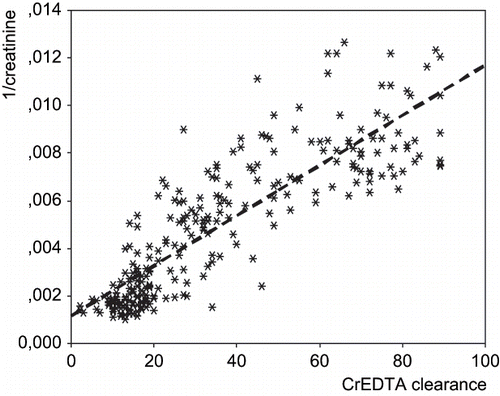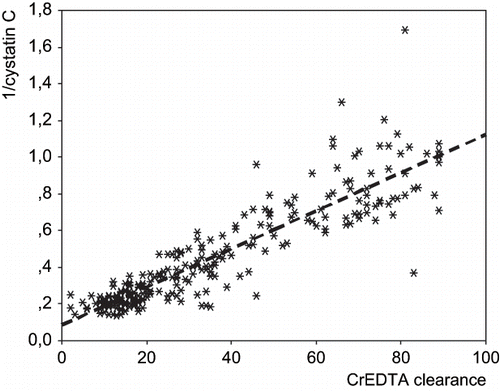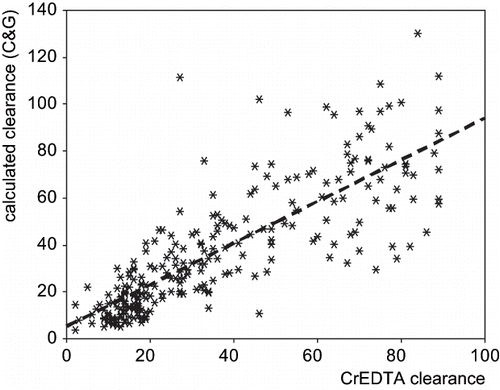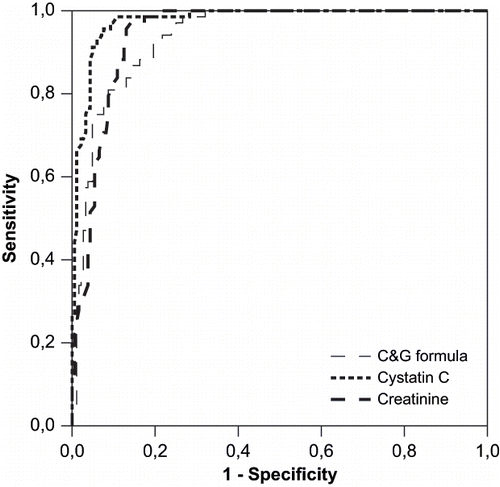Abstract
The estimation of the glomerular filtration rate (GFR) is an essential part of the evaluation of patients with chronic kidney disease (CKD). Recently, serum cystatin C has been proposed as a new endogenous marker of GFR. Authors compared serum creatinine, creatinine clearance calculated from Cockcroft and Gault formula and serum cystatin C against 51CrEDTA clearance in 252 patients with CKD and GFR <90 mL/min/1.73 m2. Analysis of correlations and diagnostic accuracy (receiver operating characteristic curves) of different GFR markers indicate that serum cystatin C is a more reliable marker of GFR in patients with CKD than serum creatinine.
INTRODUCTION
The estimation of the glomerular filtration rate (GFR) is an essential part of the evaluation of patients with chronic kidney disease (CKD).Citation[1] The ideal marker of GFR should be an endogenous molecule, which, being produced at the constant rate, is cleared solely by the kidneys via free glomerular filtration, without being secreted by tubular cells nor reabsorbed into peritubular circulation.Citation[2] An endogenous substance to satisfy all these conditions has not been found yet. Thus, there are different methods for estimation of GFR, and each of them has its advantages and disadvantages.
The “gold standard” for determining GFR is to measure the clearance of exogenous substances such as inulin, iohexol, 51CrEDTA, 99mTcDTPA or 125I-iothalamate. These techniques are time-consuming, labor-intensive, and expensive, and require the administration of substances that make them incompatible with routine monitoring.Citation[3] In clinical practice, serum creatinine concentration is the most commonly used marker to estimate GFR, on the assumption that creatinine is completely filtered across the glomerulus and that creatinine production and excretion is constant.Citation[4] The serum creatinine concentration is then inversely related to GFR. However, serum creatinine has significant disadvantages, such as an inability to measure renal function correctly when impairment is of 50% or less.Citation[5] Creatinine production also depends on muscle mass and is age- and sex-related.Citation[6] The current Kidney Disease Outcomes Quality Initiative (K/DOQI) guidelines emphasize the need to assess kidney function using predictive equations rather than serum creatinine alone.Citation[7] In Europe, the Cockcroft and Gault (C&G) formula is widely used to estimate the creatinine clearance from serum creatinine concentration with a correction for age, muscle mass, and sex.Citation[8] However, all of these formulas are also limited by a lack of validation in the full range of GFR to which they are applied.Citation[9]
Recently, serum cystatin C has been proposed as a new endogenous marker of GFR.Citation[10] This protease inhibitor with a low molecular weight is produced at a constant rate by all nucleated cells. It is freely filtered across the glomerular membrane and reabsorbed and metabolized in the proximal tubule.Citation[11] In the opposite of serum creatinine, serum cystatin C does not depend on muscle mass, sex, and age.Citation[12] Considering known facts, in clinical practice, serum cystatin C could be a better indicator of GFR than serum creatinine concentration in patients with CKD.
The aim of our study was to compare serum creatinine and serum cystatin C against 51CrEDTA clearance in patients with CKD. We also compared serum cystatin C and creatinine clearance calculated from C&G formula against 51CrEDTA clearance in the same patients.
PATIENTS AND METHODS
In our study, 252 patients with CKD and GFR <90 mL/min/1.73m2 who had performed 51CrEDTA clearance were enrolled, 118 (46.8%) women and 134 (53.2%) men. Mean age of in the study included patients was 59.8 years, range from 14 to 85 years.
Height and weight were recorded. In all patients included in the study, 51CrEDTA clearance was estimated. At the same time as 51CrEDTA clearance was estimated, serum creatinine and serum cystatin C were measured. Serum creatinine was measured by the kinetic method according to Jaffe without deproteinization (Roche Diagnostics), serum cystatin C was measured by particle-enhanced immunonephelometric method (Dade Behring). 51CrEDTA clearance was determined by single bolus method. 51CrEDTA clearance was calculated mathematically on the basis of body weight and height. Blood samples were taken four times: before the administration of the radiolabeled marker, and 120, 180, and 240 minutes after parenteral application of the marker. On the basis of the measurement of the gamma radiation 51CrEDTA clearance was calculated in mL/min/1.73m2. Creatinine clearance was calculated according to C&G formula:
For women, the correction factor of 0.85 was used.
The C&G formula was standardized for a 1.73 m2 body surface area (according to DuBois and DuBois method).
In statistical analysis, SPSS for Windows (version 12.0.1) and MedCalc for Windows (version 5.00.020) were used. Mean values, range and standard deviation (SD) were calculated.
Pearson's correlation coefficient was used for defining the correlation between 51CrEDTA clearance and the reciprocal of serum creatinine and the reciprocal of serum cystatin C and with creatinine clearance calculated from C&G formula. The Spearman rank correlation coefficient was used for defining the correlation between 51CrEDTA clearance and serum creatinine and serum cystatin C. In order to determine the diagnostic accuracy of cystatin C in comparison to the other markers of GFR, receiver operating characteristic (ROC) plots were constructed and analyzed. The area under the curve (AUC) describes the test's overall performance and is used to compare different tests. The GFR determined with 51CrEDTA was used as the gold standard and the cut-off value was set at 80, 70, 60, 50, 40, and 30 mL/min/1.73 m2.
The study protocol was in conformity with ethical guidelines, and informed consent was obtained from each participant.
RESULTS
Mean 51CrEDTA clearance in our patients was 35.9 mL/min/1.73 m2, ranging from 2 to 89 mL/min/1.73 m2 (SD ± 24.3). Mean serum creatinine concentration value was 315 μmol/L, ranging from 79 to 984 μmol/L (SD ± 217.4). Serum cystatin C concentration values were from 0.59 to 7.23 mg/L, mean value was 3.05 mg/L (SD ± 1.62). A statistically significant correlation was found between 51CrEDTA clearance with serum creatinine (r = −0.880; p < 0.0001), serum cystatin C (r = −0.896; p < 0.0001), reciprocal of serum creatinine (r = 0.855; p < 0.0001; see ), reciprocal of serum cystatin C (r = 0.898; p < 0.0001; see ), and also with calculated creatinine clearance (C&G) (r = 0.811; p < 0.0001; see ). In comparing the correlation coefficients, we found that the correlation between the reciprocal of serum cystatin C and 51CrEDTA clearance was superior to that of reciprocal of serum creatinine and 51CrEDTA clearance (p < 0.036). The correlation between the reciprocal of serum cystatin C and 51CrEDTA clearance was superior also to calculated creatinine clearance from C&G formula and 51CrEDTA clearance (p < 0.0002).
Figure 1. Correlation between 51CrEDTA clearance (mL/min/1.73 m2) and reciprocal of serum creatinine (1/μmol/L) (r = 0.855; p < 0.0001).

Figure 2. Correlation between 51CrEDTA clearance (mL/min/1.73 m2) and reciprocal of serum cystatin C (1/mg/L) (r = 0.898; p < 0.0001).

Figure 3. Correlation between 51CrEDTA clearance (mL/min/1.73 m2) and creatinine clearance, calculated from Cockcroft and Gault formula (mL/min/1.73 m2) (r = 0.811; p < 0.0001).

Diagnostic accuracy (AUCs) at cut-off values for GFR 80, 70, 60, 50, 40, and 30 mL/min/1.73 m2 of different tests is presented in . ROC curve analysis for all patients included in the study showed that serum cystatin C had significantly higher diagnostic accuracy than serum creatinine at cut-off values 70 mL/min/1.73 m2 GFR (p < 0.032), 60 mL/min/1.73 m2 GFR (p < 0.042), 50 mL/min/1.73 m2 GFR (p < 0.009; see ), and 40 mL/min/1.73 m2 GFR (p < 0.008). No significant difference in diagnostic accuracy at cut-off value 80 mL/min/1.73 m2 (p < 0.352) and 30 mL/min/1.73 m2 (p < 0.927) was found. Serum cystatin C had significantly higher diagnostic accuracy than calculated creatinine clearance from C&G formula at cut-off value 60 mL/min/1.73 m2 GFR (p < 0.028), 50 mL/min/1.73 m2 GFR (p < 0.042; see ), and 40 mL/min/1.73 m2 GFR (p < 0.042). The difference of the AUCs between serum cystatin C and calculated creatinine clearance from C&G formula did not reach significance for GFR cut-off 80 mL/min/1.73 m2 (p < 0.468), 70 mL/min/1.73 m2 (p < 0.173), and for GFR cut-off 30 mL/min/1.73 m2 (p < 0.211), despite the fact that AUCs were higher for serum cystatin C (see ).
Table 1 ROC curves comparisons for serum cystatin C, serum creatinine, and calculated creatinine clearance from Cockcroft-Gault formula
DISCUSSION
The results of our study in patients with different stages of chronic kidney disease indicate that serum cystatin C is reliable marker of GFR in patients with decreased GFR. The correlation between “gold standard” 51CrEDTA clearance and reciprocal of serum cystatin C was significantly better than correlation between 51CrEDTA clearance and reciprocal of serum creatinine. The correlation between the reciprocal of serum cystatin C and 51CrEDTA clearance was better also to that of creatinine clearance calculated from C&G formula and 51CrEDTA clearance. According to our results serum cystatin C had also significantly higher diagnostic accuracy than serum creatinine for cut-off level 70, 60, 50, and 40 mL/min/1.73 m2 GFR. Serum cystatin C had also significantly higher diagnostic accuracy than calculated creatinine clearance for cut-off level 60, 50, and 40 mL/min/1.73 m2 GFR.
There are different methods for the estimation of GFR, and in many European countries the standard method for estimation of GFR is 51CrEDTA clearance. The method of 51CrEDTA clearance with single bolus of 51CrEDTA is comparable with inulin clearance, which is the golden standard for GFR measurement. Citation[13] Serum creatinine is the most often used method for GFR estimation in clinical practice, but it is often not accurate enough. Creatinine is released relatively steadily from muscle tissue, its concentration in the serum changing daily less than 10%. Creatinine is freely filtered: it is not reabsorbed nor metabolized in kidneys, but partially secreted into proximal tubule. Tubular secretion causes an increase of creatinine clearance for 10–20%.Citation[14] As serum concentration increase, the tubular secretion of creatinine increases, leading to an overestimation of GFR in patients with moderate to severe decreases of GFR.Citation[5] Serum creatinine concentration depends on muscle mass and food intake (e.g., meat in diet). Another disadvantage is that serum creatinine is usually measured by the Jaffe reaction, based on the chromogen reaction. According to this method, other non-creatinine chromogens are present in serum that can't be found in urine. Thus, creatinine concentration is overestimated in serum, and the calculated clearance is underestimated (for 10–20%). Serum creatinine is also insensitive for detecting small decreases in GFR because of a non-linear relationship between serum concentration and GFR.Citation[5] With normal kidney function, irregularities are abolished, so that creatinine clearance is very close to the inulin clearance. At the very beginning of the renal disease, tubule secretion increases and causes false increase of GFR.Citation[15],Citation[16] A number of drugs used in clinical practice affect this tubular secretion of creatinine and thus may raise the serum creatinine and reduce the calculated creatinine clearance (e.g., trimethoprim, cimetidine). Creatinine clearance gives a better estimate of GFR than serum creatinine concentration, but it requires inconvenient urine collection.Citation[16]
Due to these facts, there is a need for a new marker of GFR that can be easily measured; would not depend on age, gender, weight, height, and food intake; and cannot be influenced by the concentration of other substances in the serum. Serum cystatin C, a new endogenous marker of renal function, is believed to be superior to serum creatinine concentration as an indicator of renal function.Citation[17],Citation[18] It is protease inhibitor produced by nucleated cells at a constant rate and is freely filtered through glomerular membrane.Citation[10],Citation[11] A great part is catabolized in proximal tubule, but it is not secreted or returned into blood flow. This latter property negates the calculation of cystatin C clearance using urine concentrations of cystatin C, but its serum concentration is a good marker of GFR. Its concentration cannot be affected by inflammation, fever, and/or outside agents.Citation[11] There are contradictory data considering the possible influence of malignant diseases on the serum concentration of cystatin C; however, most authors have the opinion that malignant processes do not influence on serum cystatin C concentration.Citation[11],Citation[19–21] Another advantage of cystatin C is that its referential values do not differ in children and adults, and they do not depend on gender, age, or muscle mass.Citation[22],Citation[23] Serum cystatin C concentration is a better indicator of GFR than creatinine serum concentration in patients with spine injury, liver cirrhosis, diabetes, or mild to moderate impaired kidney function.Citation[24–29] In elderly, serum creatinine is unreliable as an indicator of GFR, and it is usually difficult to obtain a reliable assessment of creatinine clearance in these patients.Citation[30],Citation[31] The C&G formula is also unreliable for the estimation of GFR in elderly subjects.Citation[30–32] Recent studies indicated that serum cystatin C concentration is a better marker than serum creatinine concentration and creatinine clearance calculated from C&G for the detection of changes in GFR in the elderly.Citation[31],Citation[33–35]
Our study, which included 252 patients with GFR <90 mL/min/1.73 m2, showed that serum cystatin C and/or reciprocal of serum cystatin C are more reliable markers of GFR than serum creatinine and/or reciprocal of serum creatinine. The diagnostic accuracy for cystatin C is also significantly higher than that for serum creatinine in patients with mild to moderate impaired GFR.
The current Kidney Disease Outcomes Quality Initiative (K/DOQI) guidelines emphasize the need to assess kidney function using predictive equations, and in Europe, the C&G formula is widely used to estimate the creatinine clearance from serum creatinine concentration with a correction for age, muscle mass and sex.Citation[7],Citation[8] All of these formulas are also limited by lack of validation in the full range of GFR to which they are applied.Citation[9] Available data considering serum cystatin C as a marker of GFR in patients with impaired kidney function, comparing serum cystatin C with creatinine clearance calculated from C&G formula, are few and contradictory, and included only a small number of patients.Citation[2],Citation[12],Citation[36–38] According to our results, the correlation between the reciprocal of serum cystatin C and 51CrEDTA clearance was better than that of creatinine clearance calculated from the C&G formula, and 51CrEDTA clearance and serum cystatin C had higher diagnostic accuracy than calculated creatinine clearance from C&G formula at cut-off value 60, 50, and 40 mL/min/1.73 m2. AUCs were higher for serum cystatin also at cut-off values 80, 70, and 30 mL/min/1.73 m2 (not reaching significance), but probably with an increasing number of patients, the diagnostic accuracy could be statistically significant.
In conclusion, the results of our study indicated that serum cystatin C concentration is a better marker than serum creatinine for the detection of changes in GFR in patients with CKD, especially in patients with mild to moderate decreased GFR. In recent years, the estimation of serum cystatin C is not technically any more difficult, but cystatin C still includes the higher cost of the immunoassay compared with estimation of serum creatinine concentration. Further studies with a larger number of patients are needed to clarify if serum cystatin C has also higher diagnostic accuracy than calculated creatinine clearance from C&G. Minimizing diagnostic errors is important, and the accuracy of GFR is critical, specifically in patients with decreased renal function.
REFERENCES
- Heymsfield SB, Arteaga C, Maccanus C, Smith J, Moffitt S. Measurement of muscle mass in humans: Validity of the 24-hour urinary creatinine method. Am J Clin Nutr. 1983; 37: 478–494
- Donadio C, Lucchesi A, Ardini M, Giordani R, Cystatin C. β2 microglobulin, andretinol binding proteins as indicators of glomerular filtration rate: Comparison with plasma creatinine. J Pharm Biom Anal. 2001; 24: 835–842
- Laterza OF, Price CP, Scott MG. Cystatin C: An improved estimator of glomerular filtration rate?. Clin Chem. 2002; 48: 699–707
- Clausen J. Proteins in normal cerebrospinal fluid not found in serum. Proc Soc Exp Biol Med. 1961; 107: 170–172
- Perrone RD, Madias NE, Levey AS. Serum creatinine as an index of renal function: New insights into old concepts. Clin Chem. 1992; 38: 1933–1953
- James GD, Sealey JE, Alderman M, Ljungman S, Mueller FB, Pecker MS, Laragh JH. A longitudinal study of urinary creatinine and creatinine clearance in normal subjects. Race, sex, and age differences. Am J Hypertens. 1988; 1: 124–131
- National Kidney Foundation. K/DOQI Clinical practice guideline to define chronic kidney disease: Evaluation, classification and stratification. Am J Kidney Dis. 2002; 39(Suppl. 1)S1–S266
- Froissart M, Rossert J, Jacquot C, Paillard M, Houillier P. Predictive performance of the modification of diet in renal disease and Cockcroft-Gault equations for estimating renal function. J Am Soc Nephrol. 2005; 16: 763–773
- Poggio ED, Wang X, Greene T, Van Lente F, Hall PM. Performance of the modification of diet in renal disease and Cockcroft-Gault equations in the estimation of GFR in health and in chronic kidney disease. J Am Soc Nephrol. 2005; 16: 459–466
- Deinum J, Derkx FHM. Cystatin for estimation of glomerular filtration rate?. Lancet. 2000; 356: 1624–1625
- Randers E, Erlandsen EJ. Serum cystatin C as an endogenous marker of renal function: A review. Clin Chem Lab Med. 1999; 37: 389–395
- Coll E, Botey A, Alvarez L, et al. Serum cystatin C as a new marker for noninvasive estimation of glomerular filtration rate and as a marker for early renal impairment. Am J Kidney Dis. 2000; 36: 29–34
- Cameron JS, Greger R. Renal function and testing of function. Oxford Textbook of Clinical Nephrology 2nd, AM Davison, S Cameron, JP Grunfeld, DNS Kerr, E Ritz, CG Winearls. Oxford University Press, Oxford, New York, Tokyo 1998; 1: 39–69
- Levey AS, Berg RL, Gassmann JJ, Hall PM, Walker WG. Creatinine filtration, secretion and excretion during progressive renal disease. Kidney Int. 1989; 36(Suppl. 27)S73–S80
- Shemesh O, Golbetz H, Kriss JP, Myers BD. Limitations of creatinine as a filtration marker in glomerulopathic patients. Kidney Int. 1985; 28: 830–838
- Levey AS. Measurement of renal function in chronic renal disease. Kidney Int. 1990; 38: 167–184
- Keevil BG, Kilpatrick ES, Nichols SP, Maylor PW. Biological variation of cystatin C: Implication for the assessment of glomerular filtration rate. Clin Chem. 1998; 44: 1535–1539
- Newman DJ, Thakkar H, Edwards RG, Wilkie M, White T, Grubb AO. Serum cystatin C measured by automated immunoassay: A more sensitive marker of changes in GFR than serum creatinine. Kidney Int. 1995; 47: 312–318
- Kos J, B ˘tabuc, Cimerman N, Brünner N. Serum cystatin C, a new marker of glomerular filtration rate, is increased during malignant progression. Clin Chem. 1998; 44: 2556–2557
- B ˘tabuc, Vrhovec L, M ˘tabuc-˘ilih, Cizej TE. Improved prediction of decreased creatinine clearance by serum cystatin C: Use in cancer patients before and during chemotherapy. Clin Chem. 2000; 46: 193–197
- Finney H, Williams AH, Price CP. Serum cystatin C in patients with myeloma. Clin Chim Acta. 2001; 309: 1–6
- Filler G, Witt I, Priem F, Ehrich JHH, Jung K. Are cystatin and beta microglobulin better markers than serum creatinine for prediction of a normal glomerular filtration rate in pediatric subjects?. Clin Chem. 1997; 43: 1077–1078
- Bokenkamp A, Domanetzki M, Zinck R, Schumann G, Byrd D, Brodehl J. Cystatin C—a new marker of glomerular filtration rate in children independent of age and height. Pediatrics. 1998; 101: 875–881
- Dharnidharka VR, Kwon C, Stevens G. Serum cystatin C is superior to serum creatinine as a marker of kidney function: A meta analysis. Am J Kidney Dis. 2002; 40: 221–226
- Thomassen SA, Johannesen IL, Erlandsen EJ, Abrahamsen J, Randers E. Serum cystatin C as a marker of the renal function in patients with spinal cord injury. Spinal Cord. 2002; 40: 524–528
- Demirtas S, Bozbas A, Akbay A, Yavuz Y, Karaca L. Diagnostic value of serum cystatin C for evaluation of hepatorenal syndrome. Clin Chim Acta. 2001; 311: 81–89
- Mussap M, Dalla Vestra M, Fioretto P, et al. Cystatin C is more sensitive marker than creatinine for the estimation of glomerular filtration in type 2 diabetic patients. Kidney Int. 2002; 61: 1453–1461
- MacIsaac RJ, Tsalamandris C, Thomas MC, Premaratne E, Panagiotopoulos S, Smith TJ, Poon A, Jenkins MA, Ratnaike SI, Power DA, Jerums G. The accuracy of cystatin C and commonly used creatinine-based methods for detecting moderate and mild chronic kidney disease in diabetes. Diabet Med. 2007; 24(4)443–448
- Hojs R, Bevc S, Ekart R, Gorenjak M, Puklavec L. Serum cystatin C as an endogenous marker of renal function in patients with mild to moderate impaired kidney function. Nephrol Dial Transplant. 2006; 21: 1855–1862
- Fliser D, Franek E, Joest M, Block S, Mutschler E, Ritz E. Changes of renal function in the elderly-influence of hypertension and cardiac function. Kidney Int. 1997; 51: 1196–1204
- Fliser D, Ritz E. Serum cystatin C concentration as a marker of renal dysfunction in the elderly. Am J Kidney Dis. 2001; 37: 79–83
- O'Connell MB, Dwinell AM, Bannick-Mohrland SD. Predictive performance of equations to estimate creatinine clearance in hospitalized elderly patients. Ann Pharmacother. 1992; 26: 627–635
- Wasen E, Suominen P, Isoaho R, et al. Serum cystatin C as a marker of kidney dysfunction in an elderly population. Clin Chem. 2002; 48: 1138–1140
- Van Den Noortgate NJ, Janssens WH, Delanghe JR, Afschrift MB, Lameire NH. Serum cystatin C concentration compared with other markers of glomerular filtration rate in the old old. J Am Geriatr Soc. 2002; 50: 1278–1282
- Hojs R, Bevc S, Antolinc B, Gorenjak M, Puklavec L. Serum cystatin C as an endogenous marker of renal function in the elderly. Int J Clin Pharm. 2004; 24(2/3)49–54
- Hoek FJ, Kemperman FA, Krediet RT. A comparison between cystatin C, plasma creatinine and the Cockcroft and Gault formula for the estimation of glomerular filtration rate. Nephrol Dial Transplant. 2003; 18: 2024–2031
- Kyhse-Andesen J, Schmidt C, Nordin G, Andersson B, Nilsson-Ehle P, Lindstrom V, Grubb A. Serum cystatin C, determined by a rapid, automated particle-enhanced turbidimetric method, is a better marker than serum creatinine for glomerular filtration rate. Clin Chem. 1994; 40: 1921–1926
- Grubb A, Bjork J, Lindstrom V, Strerner G, Bondesson P, Nyman U. A cystatin C-based formula without anthropometric variables estimates glomerular filtration rate better than creatinine clearance using the Cockcroft-Gault formula. Scand J Clin Lab Invest. 2005; 65: 153–162
